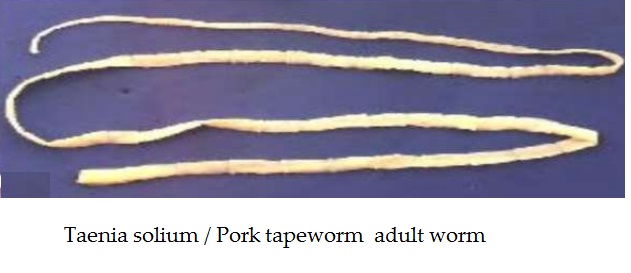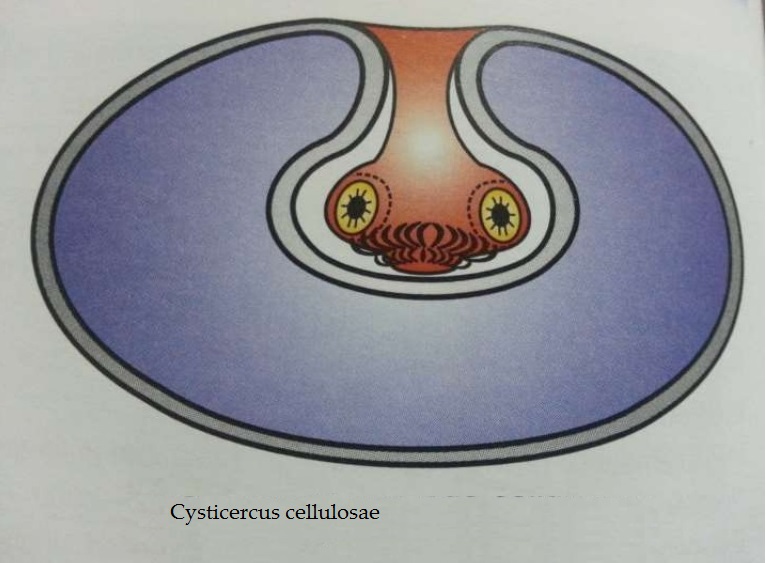Taenia solium
Introduction
Pork tapeworm
Infests humans
Acquired from pork
The worm belongs to
Kingdom : Animalia
Phylum : Platihelmenthis
Class : Cestoda
Order : Cyclophyllidea
Family : Taeniidae
Genus : Taenia
Species : Solium
Synonym : Pork tapeworm
It is an intestinal zoonotic parasite
Habitat
Adult worm lives in human intestine : upper jejunum of man.
Larval form (Cysticercus cellulose) in pig
Definitive host is human and intermediate host is pig.
Incidence
Most common in Latin America, Africa and India
Morphology
Adult : flat ribbon like, creamy white in color, 2-4 meter long
Head (scolex) consists of four suckers and a rostellum with a double crown of hooks
Neck unsegmented narrow
Body formed by several hundred proglottids. No digestive tract. Nutrition is absorbed by villi of body surface
The entire body is called a strobila consisting of hundreds of segments called proglottids
Each proglottid of Taenia solium has reproductive organs from both sexes and a complex absorption and reproduction system.
Proglottids closer to the scolex do not have sexual organs.
The further from the scolex, the more sexually mature the proglottid.
Mature proglottids contain more than 50,000 fertile eggs in a long and profusely branched central uterus.
Taenia solium is attatched to the intestinal wall with its powerful suckers and hooks.
Every few days, 2-5 gravid proglottids are detatched from the distal end and are passed with the feces.
Each proglottid liberates thousands of eggs which are fully embrionated, infective, and very resistant to adverse enviroments;
Eggs viable for up to two months in water, soil and vegetation, particularly in humid and warm environments.
Ingestion of contaminated pork causes infestation in human beings.
Epidemiology
Endemic areas include Mexico and Latin America, sub-Saharan Africa, India, and East Asia.
Clinical features
Adult tapeworms : minimal local pathology, vague abdominal discomfort, indigestion, diarrhoea, constipation, loss of appetite
An immune response to adult tapeworms provokes eosinophilia and immunoglobin E (IgE) elevation in some patients
Cysticercosis
Infection with larvae of T. solium present in human feces.
Presence of cysticercus cellulosae, the larval form in different tissues like muscle, eyes, brain : A major cause of adult onset epilepsy in the developing world; called Neurocysticercosis
Diagnosis
Detection of egg and proglottid in stool
Direct stool smear or by sedimentation technique.
Anal swab examination
Prophylaxis
Thorough cooking of the pork
Proper disposal of faecal matter
Avoid eating raw vegetables grown on soil irrigated by sewage water
Infected people treated to break parasitic life cycle
Drug treatment
Albendazole 50 mg/kg in theree divided doses daily (for 15 days
praziquentel 10mg/Kg single dose
Niclosamide single dose of 2mg
* * * * * *




